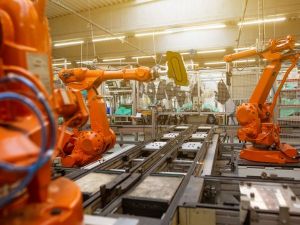Hyperautomation in Manufacturing
Source: Angie Miller, McKonly & Asbury
 In the heart of today’s rapidly evolving manufacturing landscape, a new way of doing things is dawning – one that promises to redefine how industries operate and innovate. Enter hyperautomation. Hyperautomation is a holistic approach that goes beyond traditional siloed automation by integrating various technologies to create a seamless and intelligent automation ecosystem. It involves identifying processes that can be automated, optimizing them using artificial intelligence (AI) and machine learning (ML) algorithms, leveraging robotic process automation (RPA) to execute routine tasks, and incorporating data-driven insights for continuous improvement. By combining these technologies, businesses can achieve enhanced operational agility, improved decision-making, and streamlined processes.
In the heart of today’s rapidly evolving manufacturing landscape, a new way of doing things is dawning – one that promises to redefine how industries operate and innovate. Enter hyperautomation. Hyperautomation is a holistic approach that goes beyond traditional siloed automation by integrating various technologies to create a seamless and intelligent automation ecosystem. It involves identifying processes that can be automated, optimizing them using artificial intelligence (AI) and machine learning (ML) algorithms, leveraging robotic process automation (RPA) to execute routine tasks, and incorporating data-driven insights for continuous improvement. By combining these technologies, businesses can achieve enhanced operational agility, improved decision-making, and streamlined processes.
At its core, hyperautomation in manufacturing is not just about machines performing tasks—it’s a shift that fosters a culture of innovation. A shift that is reshaping factories, supply chains, and entire business ecosystems.
Hyperautomation can manage both routine and complex tasks, freeing up human resources. When employees are freed up from repetitive tasks, human expertise is redirected towards strategic thinking and innovation. Employees are empowered to reimagine processes, explore new technologies, and pioneer alternative solutions. This leads to increased productivity and better resource utilization.
Supply chains, often intricate webs, become tightly woven systems that respond in real-time to market fluctuations. Hyperautomation’ s use of real-time data collection and analysis enable faster and more informed decision-making, allowing manufacturers to respond quickly to market changes and production issues. By automating processes across the supply chain, manufacturers can achieve better coordination, reduce lead times, and enhance inventory management.
Quality control takes on a new dimension. With the precision of AI and the vigilance of automation, manufacturers can intercept defects or deviations in real time before they make the final product, thereby reducing the likelihood of faulty products reaching customers and increasing customer satisfaction and overall brand reputation.
Cost savings find fresh avenues through hyperautomation. Automation can lead to reduced reliance on manual labor and diligent waste management, which contribute to leaner operations, resulting in a healthier bottom line.
As with any change, challenges are bound to surface. Integrating different technologies, coordinating their performance, and ensuring seamless operations require careful planning and expertise. Data security and privacy concerns also arise, underscoring the need for robust safeguards.
In this process, collaboration emerges as a key ally. Manufacturers, technologists, and domain experts must collaborate to navigate this complex landscape and steer hyperautomation towards its fullest potential. The path forward demands not just technical skill but also a visionary outlook—an understanding that hyperautomation is not an endpoint but an ongoing evolution.
In summary, hyperautomation in the manufacturing industry offers a comprehensive approach to process optimization, resource utilization, and innovation. By integrating various automation technologies, manufacturers can achieve significant operational improvements and gain a competitive edge in an increasingly dynamic business landscape.
For more information regarding our manufacturing experience, be sure to visit our Manufacturing Services page and don’t hesitate to reach out to a member of our manufacturing team.
